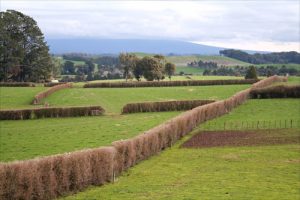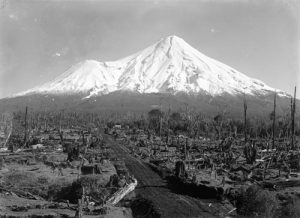 Boxthorn. Introduced to Aotearoa / New Zealand from South Africa some time in the early 1870s and not long after was brought to Taranaki where it was used for hedges on sheep and dairy farms. In Africa, it was used to keep lions out of villages. In Taranaki, the hedges prevent sheep and cattle from escaping and provide at least some shelter from the prevailing winds.
Boxthorn. Introduced to Aotearoa / New Zealand from South Africa some time in the early 1870s and not long after was brought to Taranaki where it was used for hedges on sheep and dairy farms. In Africa, it was used to keep lions out of villages. In Taranaki, the hedges prevent sheep and cattle from escaping and provide at least some shelter from the prevailing winds.
After virtually all land in Taranaki was confiscated in the 1860s, the forest was cut down and destroyed to make room for farms. Wetlands were drained, hills flattened, roads built and more and more animals were grazed to the point that feed is now supplemented with imports from across the world. The impact of industrial dairy farming on local waterways and the global climate has been devastating.

It soon became apparent that the boxthorn hedges weren’t the glorious solution either: difficult to manage, requiring heavy machinery for regular pruning, and of course invasive. Boxthorn has now been classified as plant pest and can’t be sold nor propagated. More and more hedges have been removed. However, in the sea of grass – a total mono-cultural landscape – boxthorn nowadays often provides the only bit of biodiversity, acts as a carbon sink and provides at least some shelter for the cows who are exposed to the harsh elements 365 days of the year.
And it’s not like farmers are replacing boxthorn hedges with other trees as a place of habitat for birds. They are replacing it with a fence made of chemically treated posts and wire.
Yes, it’s ironic that one would shed a tear for a digger piling up an invasive boxthorn hedge ready to put a match to it. However, in these dire ecological times, every bit of carbon in and on the ground is a climate change frontline. We all know that industrial dairying is a dead-end strategy. It is destructive on all levels: environmentally (the cows suffer, the rivers are polluted, the atmosphere is being destroyed), economically (farmers aren’t even making any money – it’s just the banks who are winning) and socially (mental health issues, loss of community in rural areas due to mechanisation).
Solutions are everywhere. The starting point is building strong, resilient and caring communities. We need to plant trees and grow food (and not commodities). We need to return confiscated lands. We need to protect waterways and the coast. We need to turn the Beehive into a skatepark and the Regional Council debating chamber into a tenpin bowling lane.
More on boxthorn: Prickles and all – Taranaki boxthorn
Photos from Te Ara

